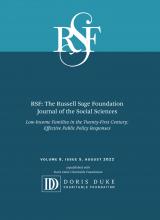Research Article
Open Access
The Earned Income Tax Credit, Family Complexity, and Children’s Living Arrangements
Katherine M. Michelmore, Natasha V. Pilkauskas
RSF: The Russell Sage Foundation Journal of the Social Sciences August 2022, 8 (5) 143-165; DOI: https://doi.org/10.7758/RSF.2022.8.5.07
Katherine M. Michelmore
aAssociate professors of public policy at the Gerald R. Ford School of Public Policy at the University of Michigan, United States
Natasha V. Pilkauskas
aAssociate professors of public policy at the Gerald R. Ford School of Public Policy at the University of Michigan, United States

REFERENCES
- ↵
- Arocho, Rachel,
- Elizabeth B. Lozano, and
- Carolyn T. Halpern
- ↵
- Burman, Leonard E
- ↵
- Carlson, Marcia, J., and
- Daniel R. Meyer
- ↵
- Center for Research on Child Wellbeing and Columbia Population Research Center (CRCW and CPRC)
- ↵
- Centers for Disease Control and Prevention (CDC)
- ↵
- Cherlin, Andrew J
- ↵
- Crandall-Hollick, Margot
- ↵
- Cross, Christina J
- ↵
- ↵
- ↵
- Edin, Kathryn,
- Timothy Nelson,
- Andrew Cherlin, and
- Robert Francis
- ↵
- ↵
- Fox, Liana
- ↵
- ↵
- Goldin, Jacob
- ↵
- Goldin, Jacob, and
- Ariel Jurow Kleinman
- ↵
- Greenstein, Robert,
- John Wancheck, and
- Chuck Marr
- ↵
- Guyton, John,
- Kara Leibel,
- Dayanand S. Manoli,
- Ankur Patel,
- Mark Payne, and
- Brenda Schafer
- ↵
- Halpern-Meekin, Sarah,
- Kathryn Edin,
- Laura Tach, and
- Jennifer Sykes
- ↵
- Harvey, Hope,
- Rachel Dunifon, and
- Natasha V. Pilkauskas
- ↵
- ↵
- Hertz, Rosanna,
- Margaret K. Nelson, and
- Wendy Kramer
- ↵
- Hoynes, Hilary W., and
- Ankur J. Patel
- ↵
- Jones, Maggie R., and
- Amy B. O’Hara
- ↵
- Kidman, Rachel,
- Rachel Margolis,
- Emily Smith-Greenaway, and
- Ashton M. Verdery
- ↵
- Kiel, Paul, and
- Jesse Eisinger
- ↵
- Kiel, Paul, and
- Hannah Fresques
- ↵
- Landers, Patrick A. and
- Margot L. Crandall-Hollick
- ↵
- ↵
- Luhr, Sigrid,
- Daniel Schneider, and
- Kristen Harknett
- ↵
- Maag, Elaine,
- H. Elizabeth, Peters, and
- Sara Edelstein
- ↵
- Maag, Elaine,
- Keven Werner, and
- Laura Wheaton
- ↵
- Manning, Wendy D., and
- Bart Stykes
- ↵
- Marr, Chuck, and
- Yixuan Huang
- ↵
- Meyer, Bruce D., and
- Dan T. Rosenbaum
- ↵
- Michelmore, Katherine M
- ↵
- Michelmore, Katherine M., and
- Natasha V. Pilkauskas
- ↵
- Miller, Cynthia,
- Lawrence F. Katz,
- Gilda Azurdia,
- Adam Isen,
- Caroline B. Schultz, and
- Kali Aloisi
- ↵
- Monte, Lindsay M
- ↵
- Nelson, Timothy J
- ↵
- Nichols, Austin,
- Elaine Sorensen, and
- Kye Lippold
- ↵
- Pilarz, Alejandra Ros,
- Heather Sandstrom, and
- Julia R. Henly
- ↵
- Pilkauskas, Natasha V., and
- Christina Cross
- ↵
- Pilkauskas, Natasha V.,
- Irwin Garfinkel, and
- Sara S. McLanahan
- ↵
- Pittman, LaShawnDa
- ↵
- Pittman, LaShawnDa
- ↵
- Randles, Jennifer
- ↵
- Ruggles, Steven,
- Sarah Flood,
- Sophia Foster,
- Ronald Goeken,
- Jose Pacas,
- Megan Schouweiler, and
- Matthew Sobek
- ↵
- Schneider, Daniel,
- Kristen Harknett, and
- Matthew Stimpson
- ↵
- Splinter, David,
- Jeff Larrimore, and
- Jacob Mortenson
- ↵
- Tamborini, Christopher R.,
- Emily Cupito, and
- Dave Shoffner
- ↵
- Tax Policy Center
- ↵
- Tong, Patricia K
- ↵
- TRAC IRS
- U.S. Census Bureau
- ↵
- U.S. Department of the Treasury (U.S. Treasury)
- ↵
- ↵
- Williams, Richard
In this issue
The Earned Income Tax Credit, Family Complexity, and Children’s Living Arrangements
Katherine M. Michelmore, Natasha V. Pilkauskas
RSF: The Russell Sage Foundation Journal of the Social Sciences Aug 2022, 8 (5) 143-165; DOI: 10.7758/RSF.2022.8.5.07
Jump to section
Related Articles
- No related articles found.
Cited By...
- No citing articles found.





